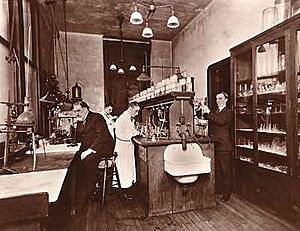Charles Norris (medical examiner) facts for kids
Quick facts for kids
Charles Norris
|
|
|---|---|
 |
|
| 1st Chief Medical Examiner of the City of New York | |
| In office 1918–1935 |
|
| Preceded by | Patrick D. Riordan (acting) |
| Succeeded by | Thomas A. Gonzales |
| Personal details | |
| Born | December 4, 1867 Hoboken, New Jersey |
| Died | September 11, 1935 (age 67) Manhattan, New York City |
| Cause of death | Heart failure |
| Nationality | American |
| Parents | Joseph Parker Norris Frances Stevens |
Charles Norris was a very important doctor in New York City. He became New York's first chief medical examiner in 1918. He was also a pioneer in forensic toxicology. This means he was one of the first to use science to solve mysteries. He helped figure out how people died.
Contents
Early Life and Education
Charles Norris was born on December 4, 1867. He went to Yale University to study science. Later, he became a doctor at Columbia University in 1892. He also studied in Europe for four years. When he came back to New York, he became a director at Bellevue Hospital in 1904.
Becoming Chief Medical Examiner
In 1917, Charles Norris wanted to become the Chief Medical Examiner for New York City. He took a special test for the job. Even though there were some legal challenges, he was chosen. Governor Charles Whitman helped make sure Norris got the position.
Norris quickly started to make his department better. He hired many smart scientists and chemists. One of them was Alexander Gettler. At first, Norris even had to buy supplies with his own money. He also worked to make sure his team had good salaries. He wanted them to focus on their important work.
Investigating "Looney Gas"
In 1924, Norris was asked to investigate a strange problem. Workers at a factory were getting sick and acting strangely. This factory made a chemical called tetraethyllead. It was used in gasoline. The building where it was made was even nicknamed the "looney gas building."
Standard Oil, the company, tried to say the chemical wasn't causing the problems. But New Jersey ordered the factory to close. A government investigation looked into it. They suggested safety rules for workers. The factory then reopened. It wasn't until 1978 that leaded gasoline was finally banned. Norris's work helped show the dangers of this chemical.
Later Life and Passing
In the spring of 1935, Norris started to feel unwell. He took a trip to South America that summer, hoping to feel better. But when he returned in August, his health got worse. He passed away on September 11, 1935, from heart failure.
Images for kids


